Sydney Harbour major events
This year the Sydney Harbour Aquatic Event program will be different from last year, so please read the sections carefully to keep up-to-date. This page will be updated as information comes to hand.
You will also find handy, tear-out sections in the December and January issues of Afloat magazine.
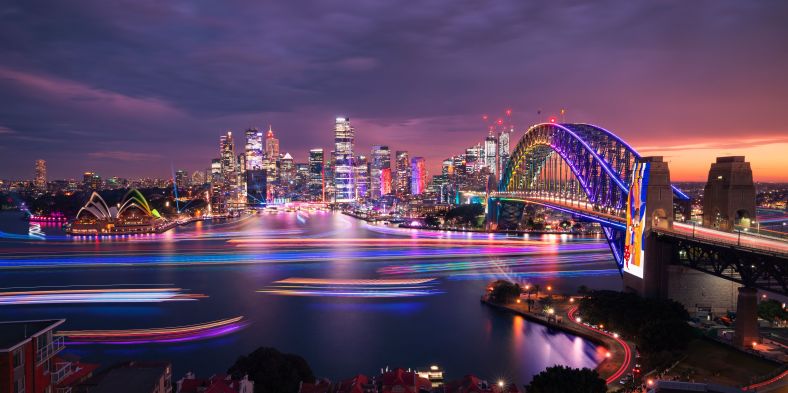
Destination NSW
There is a lot happening throughout the year and this page will help everyone stay safe and make the most of their time on the water during the major aquatic events.
Transport for NSW's maritime crews will manage marine traffic, including 6 knot speed zones, minimum wash areas and exclusion zones. They will also be enforcing boating safety requirements and waterway rules, and skippers are reminded to know and observe the boating safety rules and guidelines.
Sydney Harbour is shared by a number of different types of vessels on the water for recreational, commercial and transport uses. It is important for everyone to be respectful and patient on the water during these events.
There are many facilities and services available at "destination marinas" around the harbour. We recommend that you contact the destination marina ahead to confirm availability of the facilities you require. A map of participating marinas can be found on the Sydney Harbour Boating Destinations page.
Event information for 2023-24
Sydney-siders can once again enjoy the full range of aquatic events on our iconic harbour this summer and all indications are the waterways are going to be extremely busy over the coming months.
Exclusion zones, speed limits, minimum wash requirements and anchoring restrictions will apply on Sydney Harbour for the start of the Rolex Sydney Hobart Yacht Race on Tuesday 26 December and the Sydney New Year’s Eve fireworks on Sunday 31 December.
View or print a handy guide to the major events for December 2023 or January 2024:
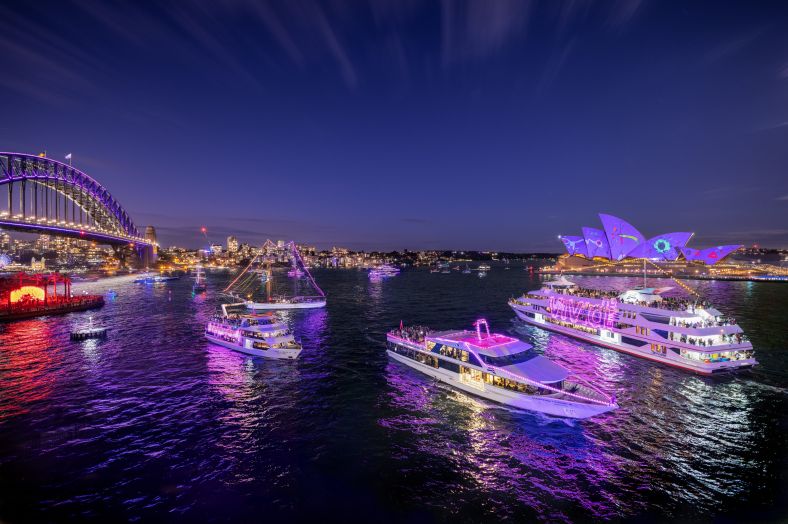
Destination NSW
Vivid Sydney is a 23 day festival which will take place from Friday 24 May to Saturday 15 June 2024.
Vivid Sydney is more than just lights. It's a sensory immersion celebrating global creative minds and technology, transforming Sydney into a vibrant canvas of stunning installations, immersive experiences, and thought provoking ideas.
The event, now in its 14th year. In 2024, the festival’s creative direction is ‘Humanity’ as we invite everyone to reflect and engage as a community in the world’s most beautiful city and celebrate what makes us human love, kindness, compassion and creativity.
Ensure you have appropriate navigation lights if you are planning on enjoying the festival from water. Refer to 'Be Bright at Night" below for more boating tips.
For more information visit www.vividsydney.com
View the boating map (PDF 338.95KB) regarding exclusion zones, restricted areas, recommended vessel path & navigation channels.
Sydney Harbour Regatta is one of the largest competitive keelboat events in Australia. A true sailing spectacle, the regatta is conducted annually by Middle Harbour Yacht Club (MHYC) with the participation and support of the major Sydney sailing clubs. The 15th staging of this event is expected to attract more than 200 keelboats racing in numerous divisions and course areas inside Sydney Harbour and offshore.
Visit MHYC over the weekend to enjoy live entertainment, great food and drinks or watch the racing from vantage points around Sydney Harbour.
More information: Middle Harbour Yacht Club (02) 9969 1244 or visit shr.mhyc.com.au
Sail GP Season 4 will be back on Sydney Harbour this year on 24th and 25th February 2024.
Racing will take place within an exclusion zone from 3pm-6pm. The race course will be set daily within the exclusion zone according to the wind direction. During the race, a 6 knot and no wash restriction will be in force 200m around the exclusion zone as detailed in the map.
There will be marked navigation channels around Bradleys Head, Vaucluse and Point Piper where ferries and other vessel will be required to keep moving. Follow directions of control vessels to dedicated spectator areas where boaters can anchor or drift to watch the racing.
Tune in to 89.3 FM Sail GP broadcast to receive live updates from race management, including racecourse position and timings to help get the best position on the water.
Please click on the map (PDF 1.38MB) for further details regarding exclusion zones & navigation channels.
For more information visit SailGP.com/Sydney

Australia Day on Sydney Harbour is a glittering spectacular and the 2024 Australia Day Harbour Program will see some of the day’s most symbolic and historic events returning to the water, as well as some new and exciting activities perfect for boaties.

We will post information on additional events for Australia Day as they become available.
The maritime map showing exclusion zones for daytime activities:
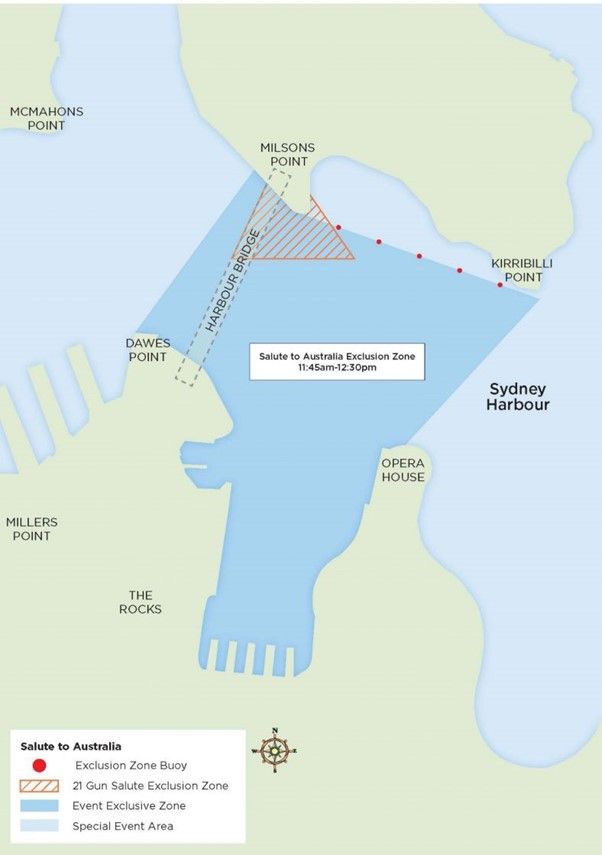
On Australia Day, Sydney Harbour transforms from a bustling working port to a stage full of fun and inspirational programming which can be enjoyed from numerous vantage points around the foreshore and on water. Many iconic favourites returning in 2024, including the Harbour Parade, Ferrython, Tall Ships Race, salute to Australia and Defence Force aerial displays.
We will post more information here as it comes to hand.
The map below shows the Maritime Exclusion Zones during Australia Day Live during the evening.

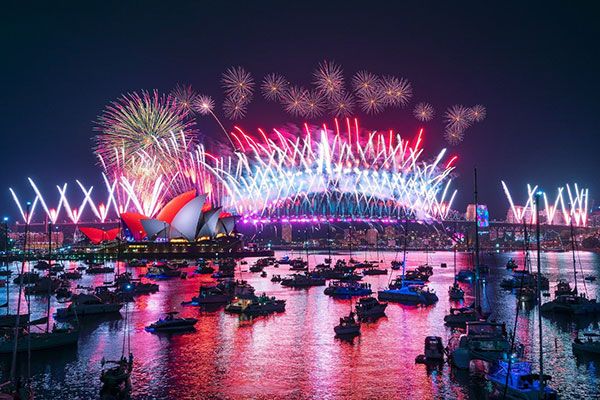
Sydney New Year’s Eve is one of the most spectacular events in the world and is back with a slightly reduced footprint this year. Celebrate the New Year with our famous fireworks displays set against glittering Sydney Harbour.
The event is produced by the City of Sydney and involves a world-renowned fireworks display and pre-show program, which includes the Commercial Vessel Association’s Lit Vessels Parade between the 9pm and midnight fireworks.
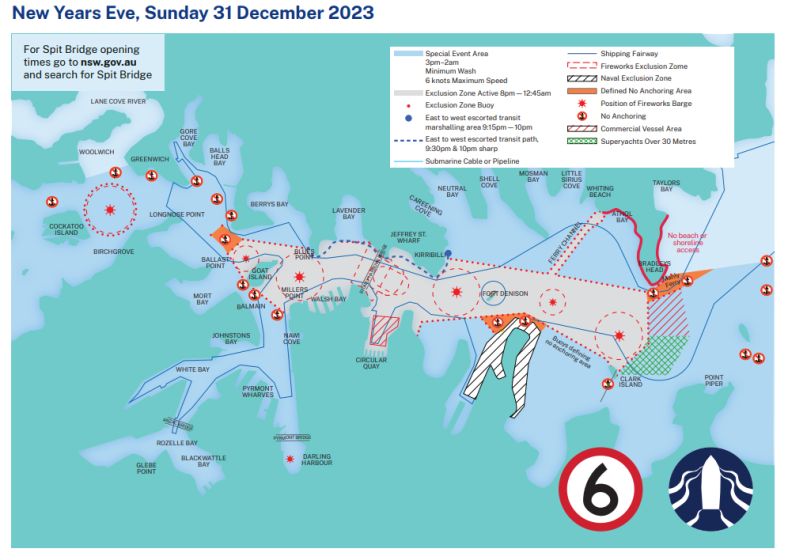

The Cruising Yacht Club of Australia’s premier blue water event, the Rolex Sydney Hobart Yacht Race, will start at 1pm on Boxing Day.
No other commercial port in the world can boast the start of such an iconic and internationally recognised blue water classic, with the natural grandeur of Sydney Harbour providing a unique backdrop for competitors and spectators alike.
Ranked as one of the most challenging and prestigious long ocean races in the world, the Rolex Sydney Hobart Yacht Race covers a distance of 628 nautical miles. As the fleet heads south into the Tasman Sea, the yachts will battle the elements before reaching the finish between two and five days later, depending on the size of the yacht and sailing conditions.
Now in its 25th year, Sail Sydney is the premier annual dinghy racing regatta in NSW for all ages.
Hosted by Woollahra Sailing Club in Rose Bay, the series will feature racing in more than 20 classes on multiple course areas across Sydney Harbour.
Competitors will range from novices entering their first regatta through to some of the best Olympic class sailors across Australia and the world.
It is a four-day event for Laser Standard, Radial and 4.7, 470 Men & Women, 49er and 49erFX, 420, 29er, Nacra 15, Techno 293, Techno Plus and RSX classes.
More information: Australian Sailing (02) 8424 7400 or visit sailsydney.org.
The Cruising Yacht Club of Australia’s Grinders Coffee SOLAS Big Boat Challenge whips up excitement around Sydney Harbour with some of the biggest and fastest yachts in the world racing in one of the greatest natural arenas on the globe.
Racing will start from 12.30pm off Point Piper and take the fleet between Sydney Heads and Farm Cove, near the Opera House, where the race will also finish.
Exclusion zones will be in place either side of the start line. Spectator vessels must observe the exclusion zone, follow instructions from control vessels and keep clear of competing yachts.
Skippers must also be mindful of their wash and distance from other spectator vessels.
More information: Cruising Yacht Club of Australia (02) 8292 7800 or visit cyca.com.au.
Safe boating during major events
During major events the harbour is busy with small and large craft, which is why it is important to follow these principles of safe navigation:
- Wear a lifejacket that is maintained and in good working condition
- Keep a proper lookout
- Maintain a safe speed. Limit your speed to 6 knots or less (equivalent to a slow jog) and minimise your wash
- Remember that creating wash can impact unreasonably on other vessels, structures or the shore, and is an offence
- Don't rush. Allow additional time for delays at boat ramps and longer travel times due to reduced speed limits in the special event areas
- Keep to the starboard (right-hand) side of channels
- Keep clear of seagoing ships, ferries and other large vessels with limited manoeuvrability. For more information on looking out for big ships, visit NSW Port Authority website and check out the guide to giving way.
- Keep at least 60 metres away from people in the water
- Keep at least 60 metres away from naval installations
- Stay inside Sydney Heads unless you and your crew are experienced, you have the right safety equipment and your vessel is seaworthy
- Avoid taking unnecessary risks
- Don't set off flares for fun, it is dangerous and illegal
- Obey navigation restrictions and follow the instructions of all control vessels.
Special conditions apply at major aquatic events to allow them to be conducted successfully, and to protect the safety of both participants and spectators. These include special event areas where speed and wash restrictions apply, and exclusion zones which are out of bounds for recreational craft.
The maps on this page provide details of the navigation restrictions for Sydney's major summer aquatic events, and are also published in notices in the NSW Government Gazette and Marine Notices published during the lead-up to the events. Additional information can also be found on the individual event websites.
Before heading out on the water, take note of the restricted areas and times. Special event areas can become very congested, especially along the edges of exclusion zones. Small craft should remain in calm waters, keeping well clear of larger craft, exclusion zones and congested areas. Wash from larger vessels can capsize or swamp small craft.
All spectator vessels must:
- Keep well clear of participating craft and support vessels
- Maintain a minimum of 50 metres from a fireworks barge which is underway
- Follow the directions of all control vessels
- Limit your wash and keep at least 30 metres clear of Transport for NSW Environmental Services vessels attending to buoys.
Exclusion zones for the major events on Sydney Harbour are marked by yellow boundary buoys and/or patrolled by official control vessels.
- Only authorised vessels (eg control vessels) can enter an exclusion zone
- Exclusion zones will also exist around vessels participating in special events.
- All non-participating vessels must observe a speed limit of 6 knots and minimise wash within 200 metres of any exclusion zone for the duration of the event
- When anchoring near an exclusion zone, stay well clear of the boundary buoys and do not allow your boat to lie over the boundary line. Allow small craft to take positions along the exclusion zone boundary.
Don't arrive late and try to push in between anchored boats and the boundary. You will be asked to move.
Tips for attending aquatic events
Lifejacket rules apply on NSW waterways and you must wear a lifejacket in a range of situations. Children aged under 12 must wear lifejackets at all times on boats less than 4.8 metres, or when they are in open areas of vessels less than 8 metres that are underway.
Lifejackets must be worn by everyone on small boats up to 4.8 metres when boating at night, or on open (ocean) waters, or when boating alone, or when instructed to by the skipper.
It can be tricky dropping anchor in a crowd of spectator vessels. Gain experience and confidence by practising anchoring before the big events, and follow these simple guidelines:
- Know the depth of water before you anchor, you will need anchor rope and chain at least three times the depth of water
- Ensure there is adequate chain on the anchor, generally one to two times the length of the boat
- Ensure you have an appropriate anchor for the size of the craft. Carry a spare anchor and rope/chain in case your main anchor gets fouled
- Keep your distance and maintain a space at least three times the length of your boat from other vessels anchored nearby
- Keep 200 metres clear of submarine cables or pipelines
- Carry fenders as spectator areas may be very crowded
- Watch the weather. Wind and waves can cause your anchor to drag
- Do not anchor close to ferry channels or exclusion zone boundaries.
Ensure you have appropriate navigation lights, particularly if you want to attend night‑time events.
- Check they are in working order and you have spare fuses, globes and torches before heading out
- Ensure navigation lights are on and working between sunset and sunrise
- Turn off cabin lights as they may reduce your ability to see
- If the vessel has a flybridge and weather permits, it is generally preferable to drive from there as you will have a better all‑round view
- Avoid using flood/spotlights high up. These lights reduce the night vision of other skippers
- When at anchor at night, show an all‑round white light where it can best be seen.
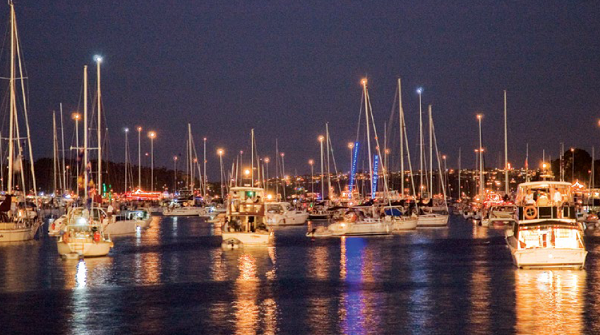
- Boaters on Sydney Harbour are reminded to keep an eye out for Little Penguins between North Head and Manly during the summer breeding season.
- A 4 knot speed limit in these 'Environmental Protected Areas' extends from Cannae Point to Smedleys Point, and includes Quarantine Bay, Store Beach, Collins Beach and Little Manly. This speed limit also continues north to 100 metres offshore from Smedleys Point toward Manly.
- Boaters must anchor at least 50 metres from the high water mark, which is identified by yellow aqua mark buoys and not in the vicinity of known seagrass beds.
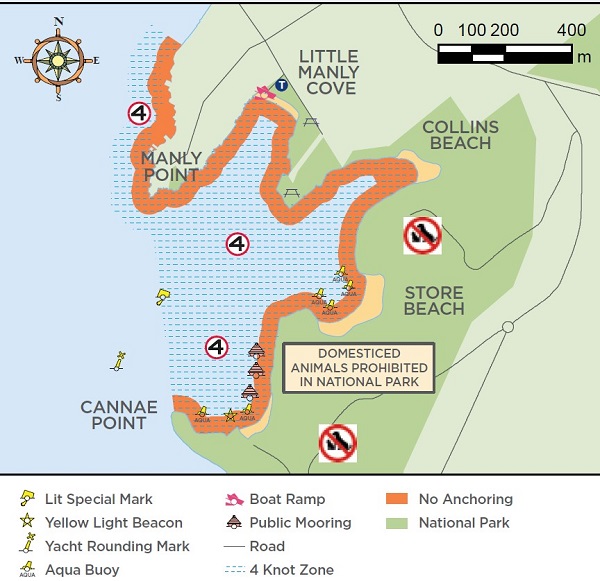
Maritime produces a comprehensive series of boating maps including Maps 9D and 9G for Sydney Harbour. They can be viewed in digital form or purchased in print on waterproof paper online.
The relevant Australian Hydrographic Service nautical chart is AUS 200. For more information visit the Australian Hydrographic Office (AHO) website.
Sydney Harbour has more to offer the general boating public with the installation of courtesy moorings and a destinations plan increasing access to services and amenities.
The pink courtesy moorings are available to moor recreational vessels for up to 24 hours, or where emergency mooring is required but not available. They provide an environmentally sensitive alternative to anchoring and are available for short term use by any registered vessel under the 20 tonne size limit.
Courtesy moorings have been installed around Sydney Harbour including Balmoral, Rose Bay, Chinamans Beach, Hermit Bay, Chowder Bay, Taylors Bay, Camp Cove, Watsons Bay, Vaucluse Bay, Nielsen Park and McMahons Point West.
The Sydney Harbour Destinations Plan is another initiative of the NSW Government to increase the number of services and amenities available to the general boating public on Sydney Harbour through participating marinas.
Facilities available include access to toilets, pump out, water and fuel, cafés, kiosks and marine services.
When out on Sydney Harbour, look for the green Boating Destination marina banner on display at participating marinas. Blue banners within the marinas show the location of available Boating Destination berths.
To find your closest destination marina or courtesy mooring, visit the Sydney Harbour Boating Destinations webpage.
It is important to have the right communication tools so you can stay informed while afloat. In the event of illness or emergency, a marine radio will give you a direct line of communication with authorities.
VHF channels 13 (commercial vessels) and 17 (event information) broadcast general safety messages including weather forecasts. Information is also available on 27.88 MHz.
In the event of an emergency on the water, communicate with authorities on radio VHF 16 or if you only have a mobile phone, call 000.
The Transport (Maritime) information line 13 12 36 operates from 8.30am to 4.30pm during all major aquatic events.
Random breath testing can be applied to skippers of boats underway. Keep below the 0.05 limit.
It can be a long day afloat and both skippers and passengers can suffer from fatigue, sunburn and wind chill. Be aware that the boating environment can multiply the effects of alcohol.
Sydney Harbour is spectacular. Let's keep it that way. It is illegal to pollute any waterways in NSW with oily bilge or galley water, litter or sewage.
Collect all your rubbish on board and dispose of it properly ashore. This includes cigarette butts and oil or grease from deck‑mounted barbecues. Stow it, don't throw it.
The Sydney Harbour Bridge transit zone shown in the diagram below has a 15 knot maximum speed limit. During some special events this may be reduced to 6 knots at times - look for the signs.
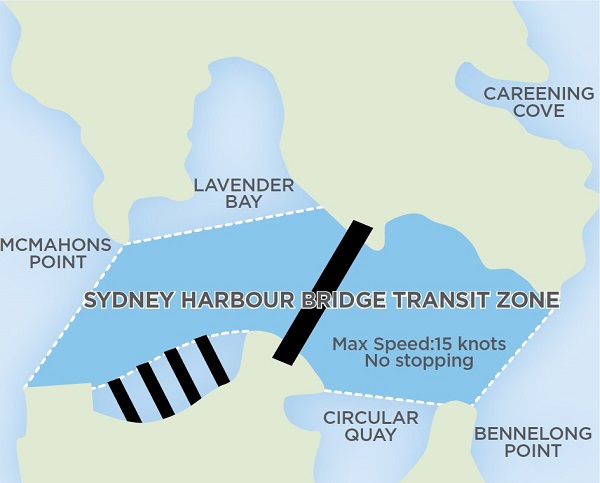
Within this zone, stopping, anchoring or drifting are prohibited other than in an emergency. Vessels may only travel through it to reach an area outside the transit zone.